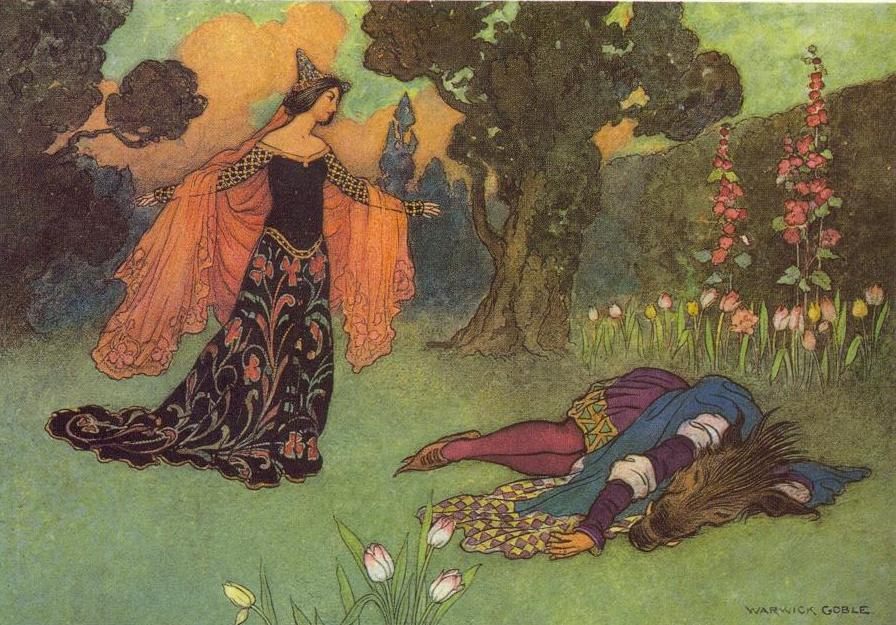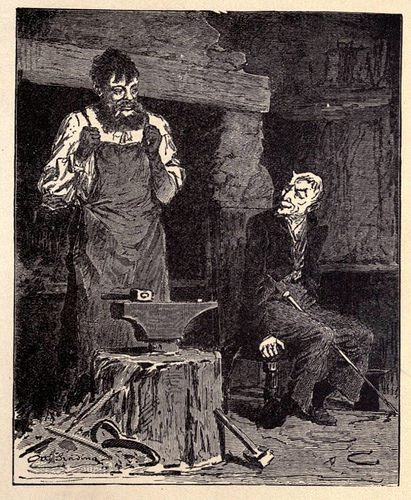The ATU Fable Index: Like the Dewey Decimal System, But With More Ogres
“The Wolf Dives Into the Water for Reflected Cheese,” and other highlights of folktale categorization.

Pick a number, any number, and I’ll tell you a story. Fifty-nine? Hunker down for “Fox and the Sour Grapes.” Eleven hundred fifty-one? Good choice—that’s “The Ogre Overawed by Displaying Objects.” Five hundred? That’s “Guessing the Helper’s Name,” or, as you might know it better, “Rumpelstiltskin.”
Such are the joys of the Aarne-Thompson Uther Tale Type Index, a massive categorization system that, in the service of scholarship, has attempted to squeeze every Indo-European folktale and fable into a salient category, complete with a corresponding number and pithy name.
“Anytime I start doing any fairytale or folk narrative research, one of the first things I do is go to the Index,” says Jeana Jorgensen, a lecturer at the University of California, Berkeley’s folklore program. “It’s indispensable.”

Jorgensen studies gender and sexuality in fairy tales and folk tales, and tale types help her compare how the same basic story—Cinderella 510A, for example—is told in different geographic locations. Throughout our conversation, she rattles off tale type names and numbers as though they’re old friends: Beauty and the Beast 425C, Little Red Riding Hood 333.
While some tale types, like those three, are named after their most familiar versions, others are given a descriptive title that sums up the mini-genre’s most vital plot points. “Some of these stories are really culturally specific, but you have to have a general enough name that you get the sense of what it’s about,” says Jorgensen. The result is a litany of names that are evocative, or absurd, or (often) both—a catalogue of the weird ways humans have explained the world to each other and themselves.

The current system, the ATU Tale Type Index, was introduced in 2004, but it’s the latest step in a folklore categorization project that has been going on for generations. It started in the early 20th century, when Antti Aarne, a Finnish folklorist, took it upon himself to organize all the tales currently present in Scandinavian collections into several thousand named and numbered categories. “Animal Tales” (like “Curing a Sick Lion” and “The Wolf Dives Into the Water for Reflected Cheese”) got numbers one through 299, followed by stories that fell under “Tales of Magic” (300-729), “Tales of the Stupid Ogre” (2009-2430), and so forth. Aarne published the results in German in 1910, under the title Index of Types of Folktales.
In 1928, the American folklorist Stith Thompson revised and added to Aarne’s index, plus translated it into English. He took another stab at it in 1961, editing and updating his own work. By this point, the system—now called the AT Tale Type Index, for Aarne-Thompson—was in widespread use. “The academic folklore community has reason to remain eternally grateful to [Aarne and Thompson],” the folklore expert Alan Dundes wrote in 1997. “The use of [the index] serves to distinguish scholarly studies of folk narrative from those carried out by a host of amateurs and dilettantes.”
After the second revision, though, certain scholars, including Dundes, started surfacing and discussing various critiques of the AT Index. Some of these were methodological, and focused on the criteria used to sort stories, or questioned the utility of sorting at all. Others were sociopolitical. “A lot of the titles of the earlier tale types were actually kind of sexist,” says Jorgensen. “They would erase female agency.”

She gives as an example one of her favorite tale types, number 451, in which a maiden goes to great length to rescue her seven brothers, who have been transformed into ravens (or, in some versions, swans or rooks). Under the Aarne-Thompson system, this type of story was called “The Brothers Who Were Turned Into Birds,” despite the fact that their sister is the clear protagonist.
This kind of thing was particularly disappointing because, as the scholar Torborg Lundell explained in a 1986 paper, unabridged versions of folktales are often more complex than their popular reinterpretations. “The model for female conduct reflected in [folktales and fairytales]… is far from confined to the submissive beauty of popular selections and Walt Disney’s dramatizations,” Lundell writes.
So in the early 2000s, another folklorist, Hans-Jörg Uther of Germany—the “U” in “ATU”—stepped up to the plate. Along with a team of international researchers, Uther consolidated similar tale variants, rewrote summaries, and added over 250 new types and subtypes (such as 777A*, “The Man in the Moon”). The team also made a special effort to include tales from underrepresented groups, and to correct for sexism. ATU 451, for example, is now called “The Maiden who Rescues Her Brothers.” The result, a three-volume work titled The Types of International Folktales, is over twice as long as previous efforts.

Researchers are, it seems, having a blast with it. Jorgensen recently used the classification system to study tales in which a heroine is forced to maintain a vow of silence, including ATUs 451, 533 (“The Speaking Horse Head”) and 442 (“The Old Woman in the Forest”). Last year, two researchers from Portugal ran a phylogenetic-style analysis on a big chunk of tale types, in an attempt to figure out the “ancestor” of today’s multitude of stories. (The strongest contender: ATU 330, “The Smith Outwits the Devil.”)
Of course, it’s still not perfect. “It’s not as multicultural as it could be,” says Jorgensen. “It’s still slim on certain parts of Africa and Asia.” Some scholars allege that tale type names continue to reflect prejudices—stories in which a beautiful princess is forced into catatonic sleep by her stepmom, for example, are currently called “Snow White,” even though they also occur in cultures where white skin is not the norm. Still others argue that having tale types at all can encourage abstraction and decontextualization.
Sometimes, though, that very abstraction and decontextualization makes for its own, curiosity-inducing poetry. Don’t you want to know what happens, across cultures, in ATU 570, also known as “Bunnies Beware of the King”?









Follow us on Twitter to get the latest on the world's hidden wonders.
Like us on Facebook to get the latest on the world's hidden wonders.
Follow us on Twitter Like us on Facebook